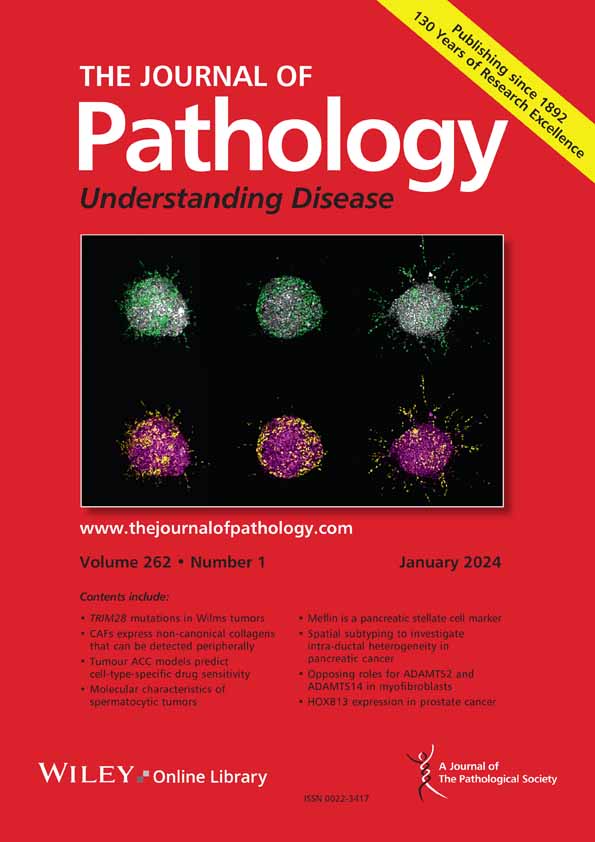Redefining phenotypic intratumor heterogeneity of pancreatic ductal adenocarcinoma: a bottom-up approach.
Marc Hilmi, Flore Delecourt, Jérôme Raffenne, Taib Bourega, Nelson Dusetti, Juan Iovanna, Yuna Blum, Magali Richard, Cindy Neuzillet, Anne Couvelard, Matthieu Tihy, Louis de Mestier, Vinciane Rebours, Rémy Nicolle, Jérôme Cros
求助PDF
{"title":"Redefining phenotypic intratumor heterogeneity of pancreatic ductal adenocarcinoma: a bottom-up approach.","authors":"Marc Hilmi, Flore Delecourt, Jérôme Raffenne, Taib Bourega, Nelson Dusetti, Juan Iovanna, Yuna Blum, Magali Richard, Cindy Neuzillet, Anne Couvelard, Matthieu Tihy, Louis de Mestier, Vinciane Rebours, Rémy Nicolle, Jérôme Cros","doi":"10.1002/path.6398","DOIUrl":null,"url":null,"abstract":"<p><p>Pancreatic ductal adenocarcinoma (PDAC) tumor interpatient heterogeneity has been well described with two major prognostic subtypes (classical and basal-like). An important intrapatient heterogeneity has been reported but has not yet been studied extensively due to the lack of standardized, reproducible, and easily accessible high-throughput methods. We built an immunohistochemical (IHC) tool capable of differentiating RNA-defined classical and basal-like tumors by selecting relevant antibodies using a multistep process. The successive stages of (i) an in silico selection from a literature review and a bulk transcriptome analysis of 309 PDACs, (ii) a tumor-specific selection from 30 patient-derived xenografts and single-cell data, followed by (iii) the validation on tissue microarrays in 50 PDAC were conducted. We used our final IHC panel on two independent cohorts of resected PDAC (n = 95, whole-slide, n = 148, tissue microarrays) for external validation. After digitization and registration of pathology slides, we performed a tile-based analysis in tumor areas to identify relevant marker combinations. Sequential marker selection led to the following panel: GATA6, CLDN18, TFF1, MUC16, S100A2, KRT17, PanBasal. Four different phenotypes were identified: one classical, one intermediate (KRT17+), and two basal-like (MUC16+ versus S100A2+) with specific biological properties. The presence of a minor basal contingent drastically reduced overall survival [hazard ratio (HR) = 1.90, p = 0.03], even in classical predominant PDACs. Analysis of preneoplastic lesions suggested that pancreatic carcinogenesis might follow a progressive evolution from classical toward a basal through an early intermediate phenotype. In conclusion, our IHC panel redefined and easily assessed the high degree of intra- and intertumoral heterogeneity of PDAC. © 2025 The Author(s). The Journal of Pathology published by John Wiley & Sons Ltd on behalf of The Pathological Society of Great Britain and Ireland.</p>","PeriodicalId":232,"journal":{"name":"The Journal of Pathology","volume":" ","pages":""},"PeriodicalIF":5.6000,"publicationDate":"2025-02-11","publicationTypes":"Journal Article","fieldsOfStudy":null,"isOpenAccess":false,"openAccessPdf":"","citationCount":"0","resultStr":null,"platform":"Semanticscholar","paperid":null,"PeriodicalName":"The Journal of Pathology","FirstCategoryId":"3","ListUrlMain":"https://doi.org/10.1002/path.6398","RegionNum":2,"RegionCategory":"医学","ArticlePicture":[],"TitleCN":null,"AbstractTextCN":null,"PMCID":null,"EPubDate":"","PubModel":"","JCR":"Q1","JCRName":"ONCOLOGY","Score":null,"Total":0}
引用次数: 0
引用
批量引用
Abstract
Pancreatic ductal adenocarcinoma (PDAC) tumor interpatient heterogeneity has been well described with two major prognostic subtypes (classical and basal-like). An important intrapatient heterogeneity has been reported but has not yet been studied extensively due to the lack of standardized, reproducible, and easily accessible high-throughput methods. We built an immunohistochemical (IHC) tool capable of differentiating RNA-defined classical and basal-like tumors by selecting relevant antibodies using a multistep process. The successive stages of (i) an in silico selection from a literature review and a bulk transcriptome analysis of 309 PDACs, (ii) a tumor-specific selection from 30 patient-derived xenografts and single-cell data, followed by (iii) the validation on tissue microarrays in 50 PDAC were conducted. We used our final IHC panel on two independent cohorts of resected PDAC (n = 95, whole-slide, n = 148, tissue microarrays) for external validation. After digitization and registration of pathology slides, we performed a tile-based analysis in tumor areas to identify relevant marker combinations. Sequential marker selection led to the following panel: GATA6, CLDN18, TFF1, MUC16, S100A2, KRT17, PanBasal. Four different phenotypes were identified: one classical, one intermediate (KRT17+), and two basal-like (MUC16+ versus S100A2+) with specific biological properties. The presence of a minor basal contingent drastically reduced overall survival [hazard ratio (HR) = 1.90, p = 0.03], even in classical predominant PDACs. Analysis of preneoplastic lesions suggested that pancreatic carcinogenesis might follow a progressive evolution from classical toward a basal through an early intermediate phenotype. In conclusion, our IHC panel redefined and easily assessed the high degree of intra- and intertumoral heterogeneity of PDAC. © 2025 The Author(s). The Journal of Pathology published by John Wiley & Sons Ltd on behalf of The Pathological Society of Great Britain and Ireland.


